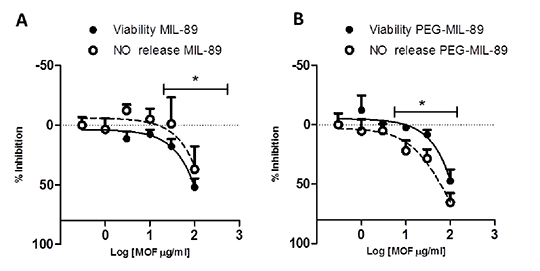Print version
Search Pub Med
Nanomedicine is a rapidly expanding area where nanoparticles are used to improve and/or reduce drugs side effects. To date; cancer is the best-studied therapeutic area for the application of nanomedicine. However, other difficult to treat conditions such as pulmonary arterial hypertension (PAH) which is a rare but fatal disease could benefit from nanomedicine approaches [1]. Currently used drugs for PAH treatment include (i) prostacyclin drugs, (ii) phosphodiesterase type 5 inhibitors, (iii) endothelin (ET) receptor antagonists and, most recently, (iv) soluble guanylate cyclase activators which are all vasodilators with limited utility due to systemic side effects. We are working on the hypothesis that a nanomedicine approach could be used to target pulmonary vessels and avoiding the systemic circulation[1] by using the Metal organic framework (MOF) MIL89 [2]. With this in mind we have prepared authentic and PEGylated MIL-89 (PEG-MIL-89) and compared stability, toxicity and anti-inflammatory effects on LPS stimulated macrophages of both preparations.
Figure 1: Toxicity (closed circles) and NO release measured as nitrite accumulation (open circles) from J774 cells (100,000 cells/ 96-well; n=8) treated with (A) MIL-89 and (B) PEG-MIL-89. Data are mean ± SEM for n determinations. Statistical significance for the effect of MOFs was determined by one-way ANOVA (*p<0.05). Methods: MIL-89 and a PEG-MIL-89 were prepared from nanoporous iron (III) carboxylate [1] as a drug carrier candidate for PAH drugs. The MOFs were characterized using infrared spectroscopy and thermal electron microscope followed by toxicology studies measuring the viability of murine macrophages cells (J774) with AlamarBlue® and inflammatory response of iNOS activity by Griess assay. Results: MIL-89 and PEG-MIL-89 retained the main functional groups and had spherical shape. At room temperature PEG-MIL-89 was relatively stable whilst MIL-89 degraded in sealed containers. Both MIL-89 and PEG-MIL-89 were not toxic to J774 cells at concentrations up to 10 μg/ml, cytotoxicity was only seen at high concentration ≥30 μg/ml (Figure1 A and B). Both preparations displayed anti-inflammatory effects by inhibiting iNOS activity in LPS stimulated J774 cells which, for PEG-MIL-89, occurred at lower concentrations than were needed to cause toxicity (Figure 1 A and B). Conclusion: Both MOFs (MIL-89 and PEG-MIL-89) represent a possible drug carrier candidate for PAH. PEG-MIL-89 was more stable and displayed a selective inhibitory effect on iNOS activity. Such anti-inflammatory effects may be useful and act in synergy with PAH drugs. 1. Bonner, J.C., et al . Card, and D.C. Zeldin, p. 751-3, 2009. 2. Horcajada, P. et al., Nat Mater, 9(2): p. 172-8, 2009
|


